PD14 International Business: Toyota's Supply Chain Vulnerabilities
VerifiedAdded on 2023/04/08
|9
|2468
|100
Report
AI Summary
This report analyzes Toyota's supply chain process within the context of international business, focusing on the impacts of potential disruptions. It examines the effects of a shortage of key materials like steel, highlighting how it can stall production, affect sourcing policies, increase customer waiting times, and raise average costs. The report also investigates the consequences of losing a key distribution site, noting the reduction in market penetration, increased transportation times, and decreased ability to manage market disruptions. Furthermore, it explores the implications of losing key suppliers and customers, emphasizing the potential barriers in the supply chain, increased bargaining power of remaining suppliers, and the loss of revenue and productivity. The report concludes with recommendations for mitigating these risks, such as diversifying suppliers, using short-term contracts, and implementing a make-to-order supply chain model to enhance flexibility and reduce dependency on specific stakeholders. This analysis provides insights into the critical factors influencing the effectiveness of Toyota's supply chain and strategies for enhancing its resilience in the face of potential disruptions.
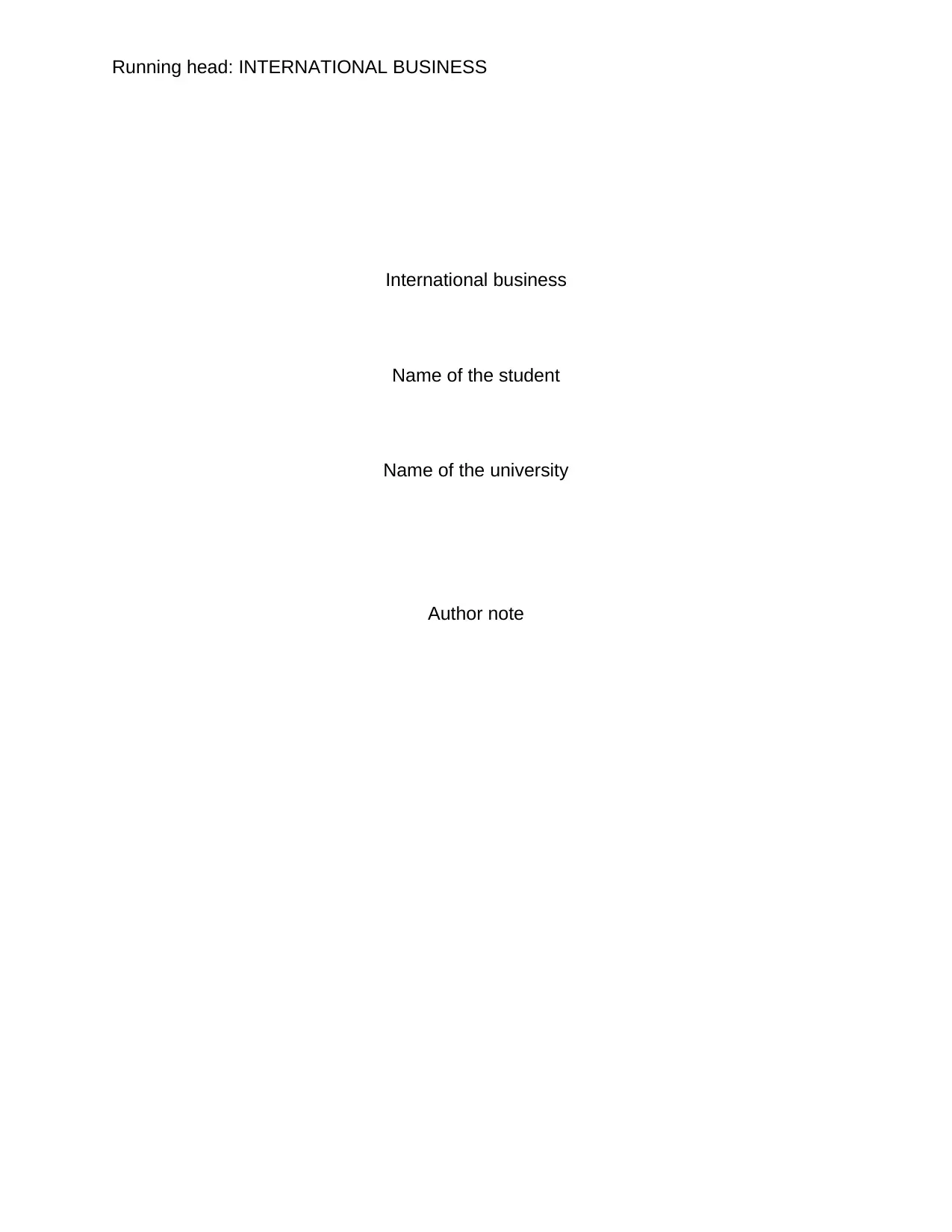
Running head: INTERNATIONAL BUSINESS
International business
Name of the student
Name of the university
Author note
International business
Name of the student
Name of the university
Author note
Secure Best Marks with AI Grader
Need help grading? Try our AI Grader for instant feedback on your assignments.
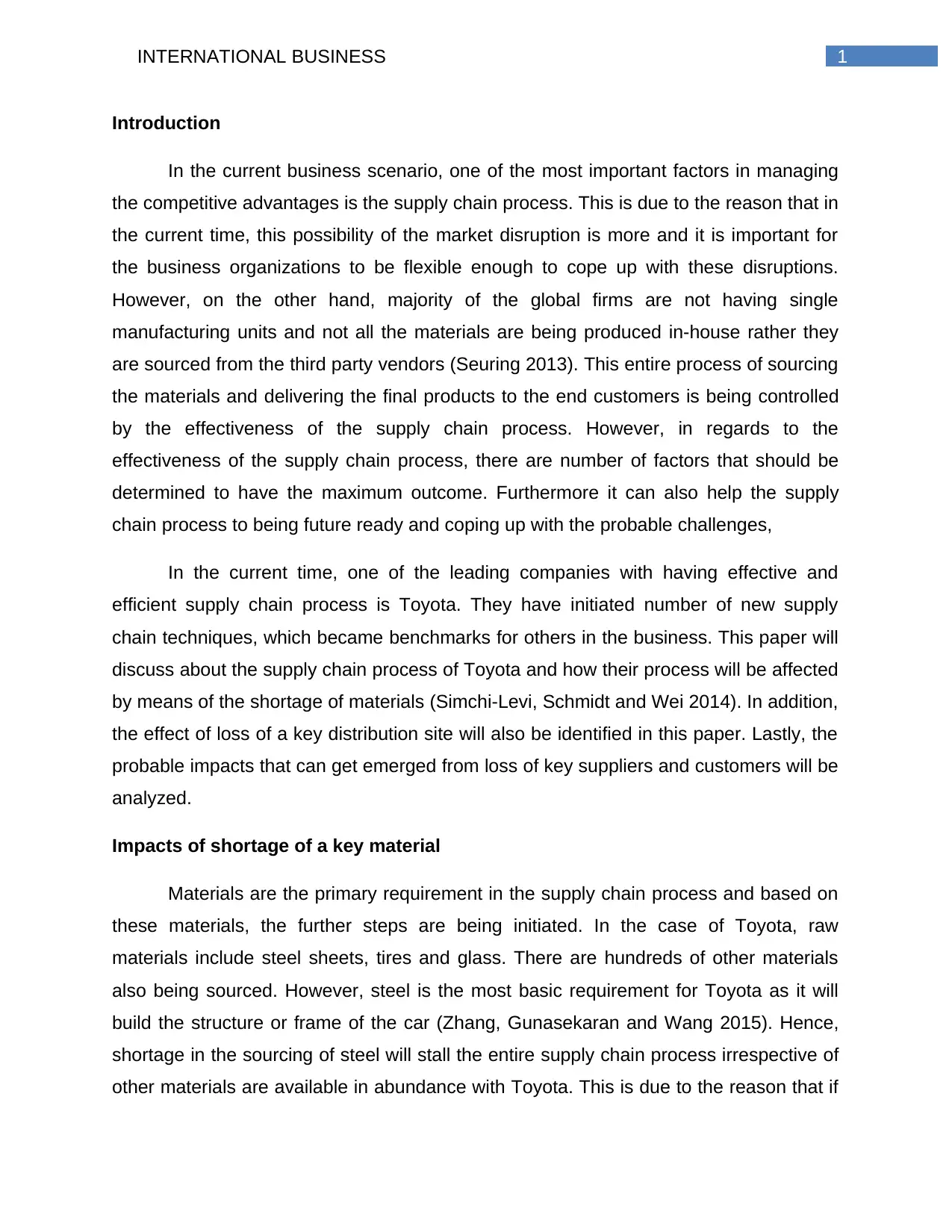
1INTERNATIONAL BUSINESS
Introduction
In the current business scenario, one of the most important factors in managing
the competitive advantages is the supply chain process. This is due to the reason that in
the current time, this possibility of the market disruption is more and it is important for
the business organizations to be flexible enough to cope up with these disruptions.
However, on the other hand, majority of the global firms are not having single
manufacturing units and not all the materials are being produced in-house rather they
are sourced from the third party vendors (Seuring 2013). This entire process of sourcing
the materials and delivering the final products to the end customers is being controlled
by the effectiveness of the supply chain process. However, in regards to the
effectiveness of the supply chain process, there are number of factors that should be
determined to have the maximum outcome. Furthermore it can also help the supply
chain process to being future ready and coping up with the probable challenges,
In the current time, one of the leading companies with having effective and
efficient supply chain process is Toyota. They have initiated number of new supply
chain techniques, which became benchmarks for others in the business. This paper will
discuss about the supply chain process of Toyota and how their process will be affected
by means of the shortage of materials (Simchi-Levi, Schmidt and Wei 2014). In addition,
the effect of loss of a key distribution site will also be identified in this paper. Lastly, the
probable impacts that can get emerged from loss of key suppliers and customers will be
analyzed.
Impacts of shortage of a key material
Materials are the primary requirement in the supply chain process and based on
these materials, the further steps are being initiated. In the case of Toyota, raw
materials include steel sheets, tires and glass. There are hundreds of other materials
also being sourced. However, steel is the most basic requirement for Toyota as it will
build the structure or frame of the car (Zhang, Gunasekaran and Wang 2015). Hence,
shortage in the sourcing of steel will stall the entire supply chain process irrespective of
other materials are available in abundance with Toyota. This is due to the reason that if
Introduction
In the current business scenario, one of the most important factors in managing
the competitive advantages is the supply chain process. This is due to the reason that in
the current time, this possibility of the market disruption is more and it is important for
the business organizations to be flexible enough to cope up with these disruptions.
However, on the other hand, majority of the global firms are not having single
manufacturing units and not all the materials are being produced in-house rather they
are sourced from the third party vendors (Seuring 2013). This entire process of sourcing
the materials and delivering the final products to the end customers is being controlled
by the effectiveness of the supply chain process. However, in regards to the
effectiveness of the supply chain process, there are number of factors that should be
determined to have the maximum outcome. Furthermore it can also help the supply
chain process to being future ready and coping up with the probable challenges,
In the current time, one of the leading companies with having effective and
efficient supply chain process is Toyota. They have initiated number of new supply
chain techniques, which became benchmarks for others in the business. This paper will
discuss about the supply chain process of Toyota and how their process will be affected
by means of the shortage of materials (Simchi-Levi, Schmidt and Wei 2014). In addition,
the effect of loss of a key distribution site will also be identified in this paper. Lastly, the
probable impacts that can get emerged from loss of key suppliers and customers will be
analyzed.
Impacts of shortage of a key material
Materials are the primary requirement in the supply chain process and based on
these materials, the further steps are being initiated. In the case of Toyota, raw
materials include steel sheets, tires and glass. There are hundreds of other materials
also being sourced. However, steel is the most basic requirement for Toyota as it will
build the structure or frame of the car (Zhang, Gunasekaran and Wang 2015). Hence,
shortage in the sourcing of steel will stall the entire supply chain process irrespective of
other materials are available in abundance with Toyota. This is due to the reason that if
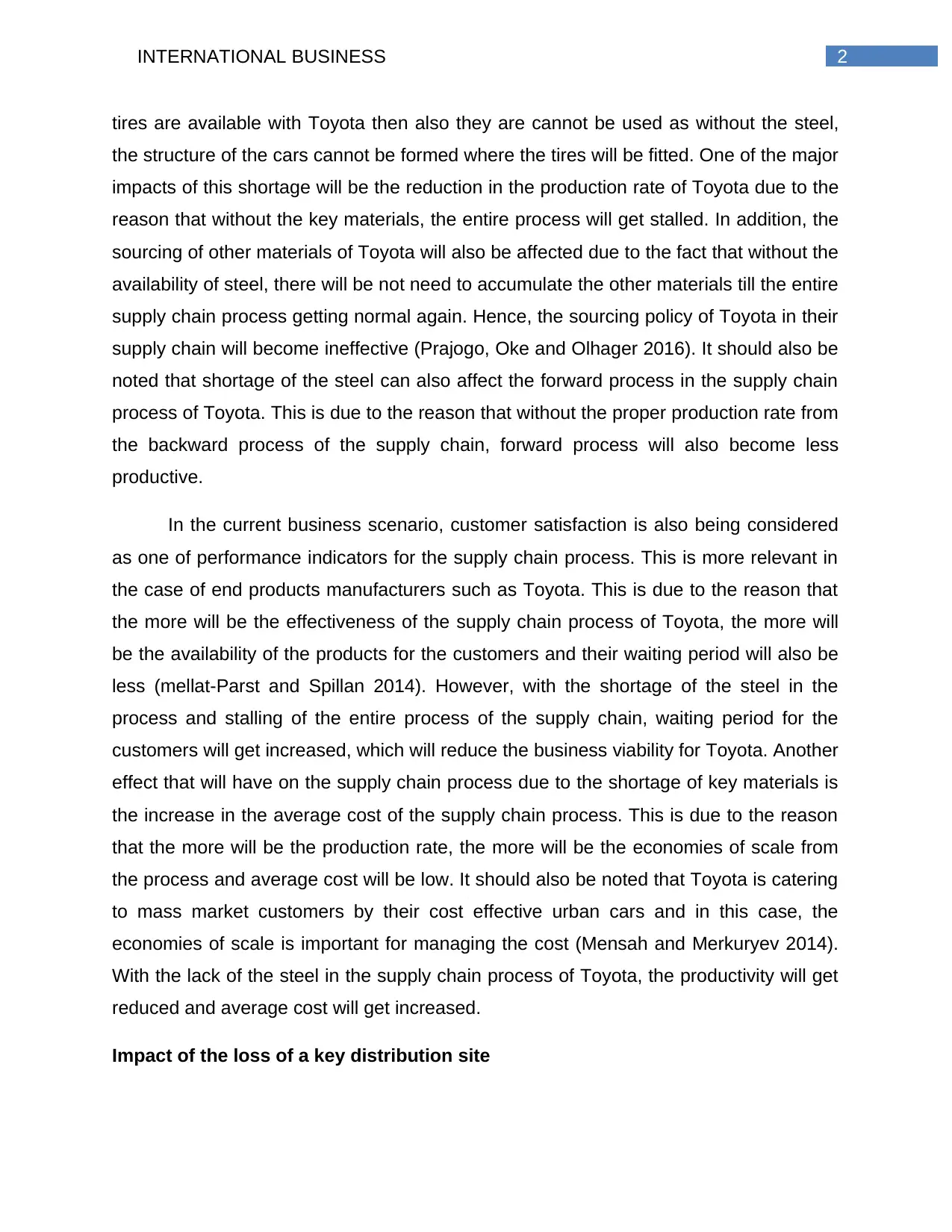
2INTERNATIONAL BUSINESS
tires are available with Toyota then also they are cannot be used as without the steel,
the structure of the cars cannot be formed where the tires will be fitted. One of the major
impacts of this shortage will be the reduction in the production rate of Toyota due to the
reason that without the key materials, the entire process will get stalled. In addition, the
sourcing of other materials of Toyota will also be affected due to the fact that without the
availability of steel, there will be not need to accumulate the other materials till the entire
supply chain process getting normal again. Hence, the sourcing policy of Toyota in their
supply chain will become ineffective (Prajogo, Oke and Olhager 2016). It should also be
noted that shortage of the steel can also affect the forward process in the supply chain
process of Toyota. This is due to the reason that without the proper production rate from
the backward process of the supply chain, forward process will also become less
productive.
In the current business scenario, customer satisfaction is also being considered
as one of performance indicators for the supply chain process. This is more relevant in
the case of end products manufacturers such as Toyota. This is due to the reason that
the more will be the effectiveness of the supply chain process of Toyota, the more will
be the availability of the products for the customers and their waiting period will also be
less (mellat-Parst and Spillan 2014). However, with the shortage of the steel in the
process and stalling of the entire process of the supply chain, waiting period for the
customers will get increased, which will reduce the business viability for Toyota. Another
effect that will have on the supply chain process due to the shortage of key materials is
the increase in the average cost of the supply chain process. This is due to the reason
that the more will be the production rate, the more will be the economies of scale from
the process and average cost will be low. It should also be noted that Toyota is catering
to mass market customers by their cost effective urban cars and in this case, the
economies of scale is important for managing the cost (Mensah and Merkuryev 2014).
With the lack of the steel in the supply chain process of Toyota, the productivity will get
reduced and average cost will get increased.
Impact of the loss of a key distribution site
tires are available with Toyota then also they are cannot be used as without the steel,
the structure of the cars cannot be formed where the tires will be fitted. One of the major
impacts of this shortage will be the reduction in the production rate of Toyota due to the
reason that without the key materials, the entire process will get stalled. In addition, the
sourcing of other materials of Toyota will also be affected due to the fact that without the
availability of steel, there will be not need to accumulate the other materials till the entire
supply chain process getting normal again. Hence, the sourcing policy of Toyota in their
supply chain will become ineffective (Prajogo, Oke and Olhager 2016). It should also be
noted that shortage of the steel can also affect the forward process in the supply chain
process of Toyota. This is due to the reason that without the proper production rate from
the backward process of the supply chain, forward process will also become less
productive.
In the current business scenario, customer satisfaction is also being considered
as one of performance indicators for the supply chain process. This is more relevant in
the case of end products manufacturers such as Toyota. This is due to the reason that
the more will be the effectiveness of the supply chain process of Toyota, the more will
be the availability of the products for the customers and their waiting period will also be
less (mellat-Parst and Spillan 2014). However, with the shortage of the steel in the
process and stalling of the entire process of the supply chain, waiting period for the
customers will get increased, which will reduce the business viability for Toyota. Another
effect that will have on the supply chain process due to the shortage of key materials is
the increase in the average cost of the supply chain process. This is due to the reason
that the more will be the production rate, the more will be the economies of scale from
the process and average cost will be low. It should also be noted that Toyota is catering
to mass market customers by their cost effective urban cars and in this case, the
economies of scale is important for managing the cost (Mensah and Merkuryev 2014).
With the lack of the steel in the supply chain process of Toyota, the productivity will get
reduced and average cost will get increased.
Impact of the loss of a key distribution site
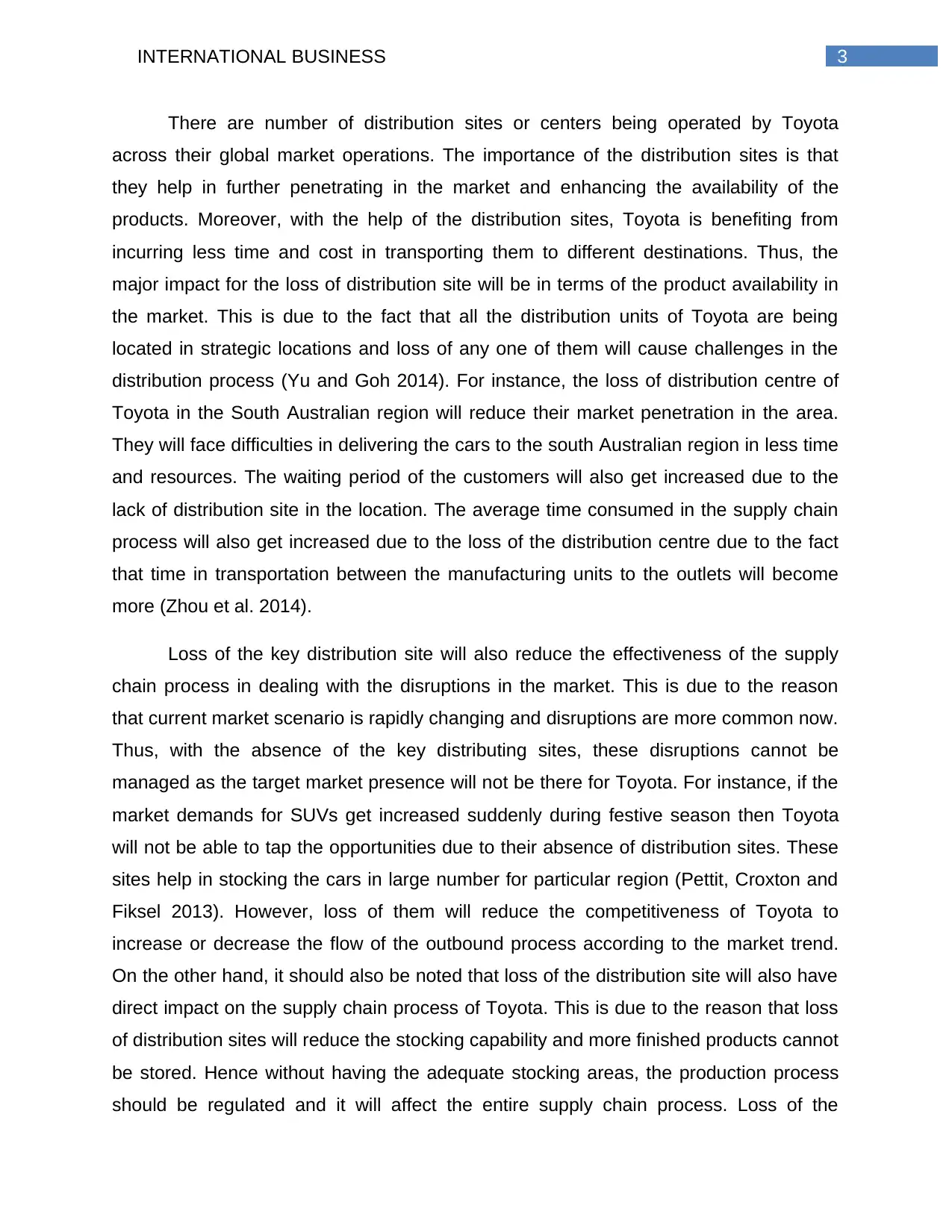
3INTERNATIONAL BUSINESS
There are number of distribution sites or centers being operated by Toyota
across their global market operations. The importance of the distribution sites is that
they help in further penetrating in the market and enhancing the availability of the
products. Moreover, with the help of the distribution sites, Toyota is benefiting from
incurring less time and cost in transporting them to different destinations. Thus, the
major impact for the loss of distribution site will be in terms of the product availability in
the market. This is due to the fact that all the distribution units of Toyota are being
located in strategic locations and loss of any one of them will cause challenges in the
distribution process (Yu and Goh 2014). For instance, the loss of distribution centre of
Toyota in the South Australian region will reduce their market penetration in the area.
They will face difficulties in delivering the cars to the south Australian region in less time
and resources. The waiting period of the customers will also get increased due to the
lack of distribution site in the location. The average time consumed in the supply chain
process will also get increased due to the loss of the distribution centre due to the fact
that time in transportation between the manufacturing units to the outlets will become
more (Zhou et al. 2014).
Loss of the key distribution site will also reduce the effectiveness of the supply
chain process in dealing with the disruptions in the market. This is due to the reason
that current market scenario is rapidly changing and disruptions are more common now.
Thus, with the absence of the key distributing sites, these disruptions cannot be
managed as the target market presence will not be there for Toyota. For instance, if the
market demands for SUVs get increased suddenly during festive season then Toyota
will not be able to tap the opportunities due to their absence of distribution sites. These
sites help in stocking the cars in large number for particular region (Pettit, Croxton and
Fiksel 2013). However, loss of them will reduce the competitiveness of Toyota to
increase or decrease the flow of the outbound process according to the market trend.
On the other hand, it should also be noted that loss of the distribution site will also have
direct impact on the supply chain process of Toyota. This is due to the reason that loss
of distribution sites will reduce the stocking capability and more finished products cannot
be stored. Hence without having the adequate stocking areas, the production process
should be regulated and it will affect the entire supply chain process. Loss of the
There are number of distribution sites or centers being operated by Toyota
across their global market operations. The importance of the distribution sites is that
they help in further penetrating in the market and enhancing the availability of the
products. Moreover, with the help of the distribution sites, Toyota is benefiting from
incurring less time and cost in transporting them to different destinations. Thus, the
major impact for the loss of distribution site will be in terms of the product availability in
the market. This is due to the fact that all the distribution units of Toyota are being
located in strategic locations and loss of any one of them will cause challenges in the
distribution process (Yu and Goh 2014). For instance, the loss of distribution centre of
Toyota in the South Australian region will reduce their market penetration in the area.
They will face difficulties in delivering the cars to the south Australian region in less time
and resources. The waiting period of the customers will also get increased due to the
lack of distribution site in the location. The average time consumed in the supply chain
process will also get increased due to the loss of the distribution centre due to the fact
that time in transportation between the manufacturing units to the outlets will become
more (Zhou et al. 2014).
Loss of the key distribution site will also reduce the effectiveness of the supply
chain process in dealing with the disruptions in the market. This is due to the reason
that current market scenario is rapidly changing and disruptions are more common now.
Thus, with the absence of the key distributing sites, these disruptions cannot be
managed as the target market presence will not be there for Toyota. For instance, if the
market demands for SUVs get increased suddenly during festive season then Toyota
will not be able to tap the opportunities due to their absence of distribution sites. These
sites help in stocking the cars in large number for particular region (Pettit, Croxton and
Fiksel 2013). However, loss of them will reduce the competitiveness of Toyota to
increase or decrease the flow of the outbound process according to the market trend.
On the other hand, it should also be noted that loss of the distribution site will also have
direct impact on the supply chain process of Toyota. This is due to the reason that loss
of distribution sites will reduce the stocking capability and more finished products cannot
be stored. Hence without having the adequate stocking areas, the production process
should be regulated and it will affect the entire supply chain process. Loss of the
Secure Best Marks with AI Grader
Need help grading? Try our AI Grader for instant feedback on your assignments.
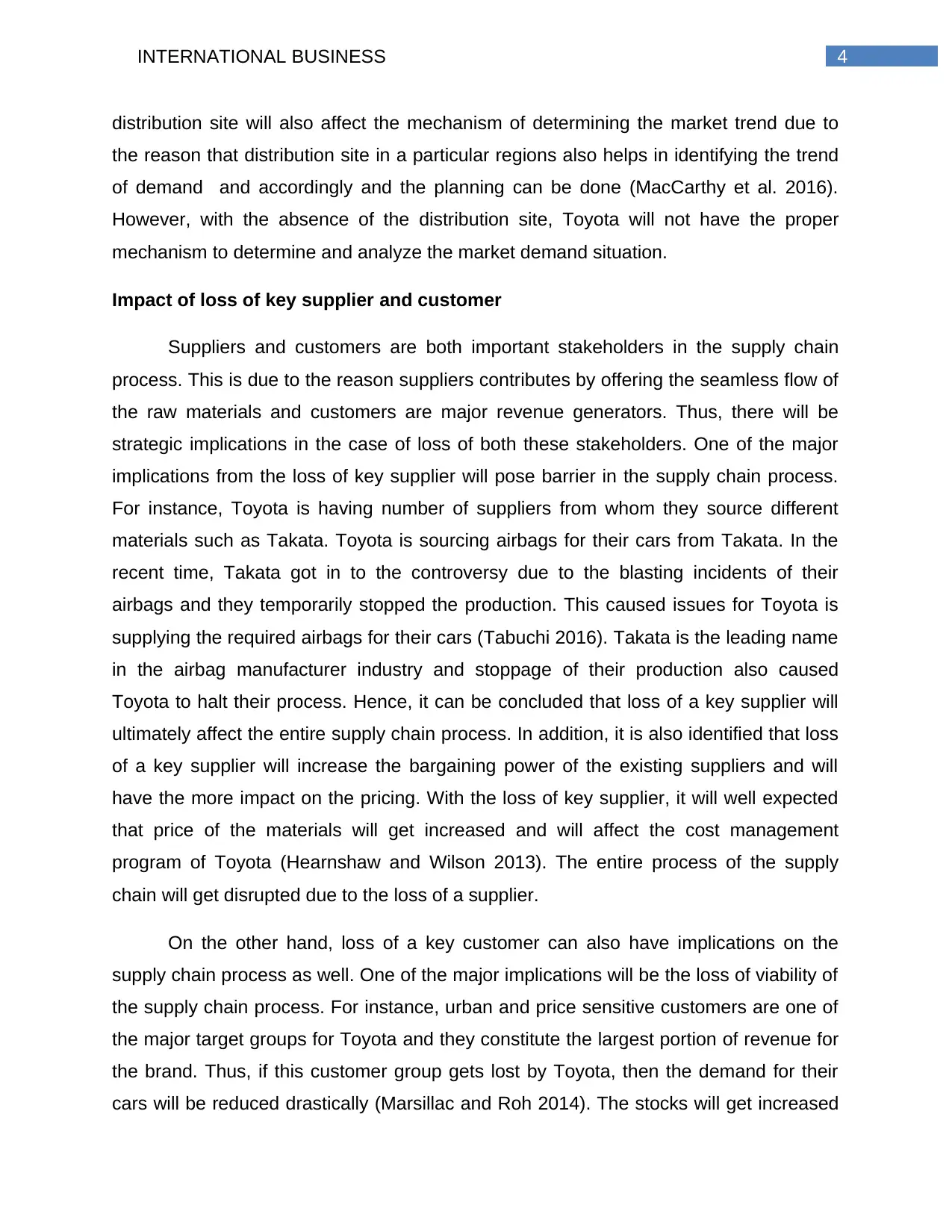
4INTERNATIONAL BUSINESS
distribution site will also affect the mechanism of determining the market trend due to
the reason that distribution site in a particular regions also helps in identifying the trend
of demand and accordingly and the planning can be done (MacCarthy et al. 2016).
However, with the absence of the distribution site, Toyota will not have the proper
mechanism to determine and analyze the market demand situation.
Impact of loss of key supplier and customer
Suppliers and customers are both important stakeholders in the supply chain
process. This is due to the reason suppliers contributes by offering the seamless flow of
the raw materials and customers are major revenue generators. Thus, there will be
strategic implications in the case of loss of both these stakeholders. One of the major
implications from the loss of key supplier will pose barrier in the supply chain process.
For instance, Toyota is having number of suppliers from whom they source different
materials such as Takata. Toyota is sourcing airbags for their cars from Takata. In the
recent time, Takata got in to the controversy due to the blasting incidents of their
airbags and they temporarily stopped the production. This caused issues for Toyota is
supplying the required airbags for their cars (Tabuchi 2016). Takata is the leading name
in the airbag manufacturer industry and stoppage of their production also caused
Toyota to halt their process. Hence, it can be concluded that loss of a key supplier will
ultimately affect the entire supply chain process. In addition, it is also identified that loss
of a key supplier will increase the bargaining power of the existing suppliers and will
have the more impact on the pricing. With the loss of key supplier, it will well expected
that price of the materials will get increased and will affect the cost management
program of Toyota (Hearnshaw and Wilson 2013). The entire process of the supply
chain will get disrupted due to the loss of a supplier.
On the other hand, loss of a key customer can also have implications on the
supply chain process as well. One of the major implications will be the loss of viability of
the supply chain process. For instance, urban and price sensitive customers are one of
the major target groups for Toyota and they constitute the largest portion of revenue for
the brand. Thus, if this customer group gets lost by Toyota, then the demand for their
cars will be reduced drastically (Marsillac and Roh 2014). The stocks will get increased
distribution site will also affect the mechanism of determining the market trend due to
the reason that distribution site in a particular regions also helps in identifying the trend
of demand and accordingly and the planning can be done (MacCarthy et al. 2016).
However, with the absence of the distribution site, Toyota will not have the proper
mechanism to determine and analyze the market demand situation.
Impact of loss of key supplier and customer
Suppliers and customers are both important stakeholders in the supply chain
process. This is due to the reason suppliers contributes by offering the seamless flow of
the raw materials and customers are major revenue generators. Thus, there will be
strategic implications in the case of loss of both these stakeholders. One of the major
implications from the loss of key supplier will pose barrier in the supply chain process.
For instance, Toyota is having number of suppliers from whom they source different
materials such as Takata. Toyota is sourcing airbags for their cars from Takata. In the
recent time, Takata got in to the controversy due to the blasting incidents of their
airbags and they temporarily stopped the production. This caused issues for Toyota is
supplying the required airbags for their cars (Tabuchi 2016). Takata is the leading name
in the airbag manufacturer industry and stoppage of their production also caused
Toyota to halt their process. Hence, it can be concluded that loss of a key supplier will
ultimately affect the entire supply chain process. In addition, it is also identified that loss
of a key supplier will increase the bargaining power of the existing suppliers and will
have the more impact on the pricing. With the loss of key supplier, it will well expected
that price of the materials will get increased and will affect the cost management
program of Toyota (Hearnshaw and Wilson 2013). The entire process of the supply
chain will get disrupted due to the loss of a supplier.
On the other hand, loss of a key customer can also have implications on the
supply chain process as well. One of the major implications will be the loss of viability of
the supply chain process. For instance, urban and price sensitive customers are one of
the major target groups for Toyota and they constitute the largest portion of revenue for
the brand. Thus, if this customer group gets lost by Toyota, then the demand for their
cars will be reduced drastically (Marsillac and Roh 2014). The stocks will get increased
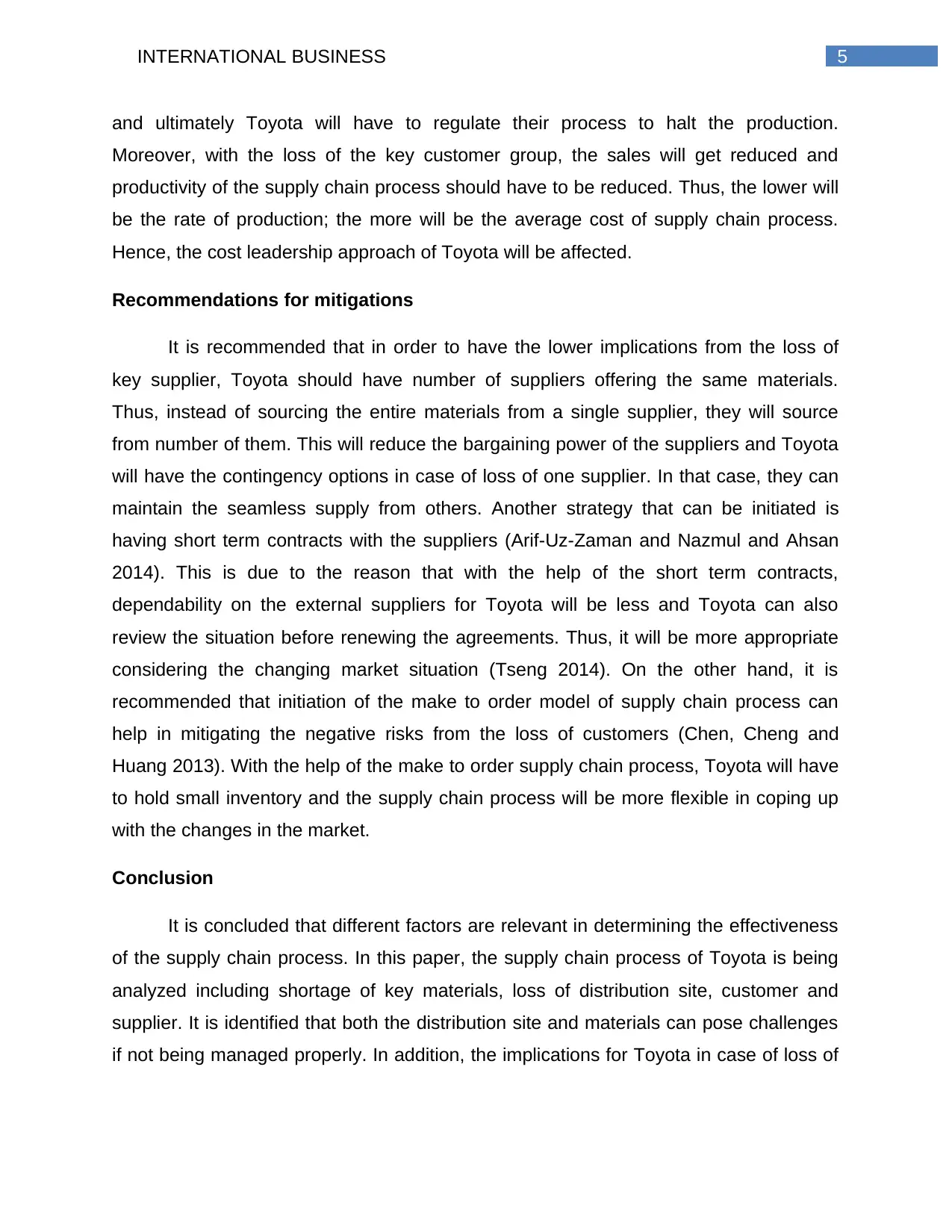
5INTERNATIONAL BUSINESS
and ultimately Toyota will have to regulate their process to halt the production.
Moreover, with the loss of the key customer group, the sales will get reduced and
productivity of the supply chain process should have to be reduced. Thus, the lower will
be the rate of production; the more will be the average cost of supply chain process.
Hence, the cost leadership approach of Toyota will be affected.
Recommendations for mitigations
It is recommended that in order to have the lower implications from the loss of
key supplier, Toyota should have number of suppliers offering the same materials.
Thus, instead of sourcing the entire materials from a single supplier, they will source
from number of them. This will reduce the bargaining power of the suppliers and Toyota
will have the contingency options in case of loss of one supplier. In that case, they can
maintain the seamless supply from others. Another strategy that can be initiated is
having short term contracts with the suppliers (Arif-Uz-Zaman and Nazmul and Ahsan
2014). This is due to the reason that with the help of the short term contracts,
dependability on the external suppliers for Toyota will be less and Toyota can also
review the situation before renewing the agreements. Thus, it will be more appropriate
considering the changing market situation (Tseng 2014). On the other hand, it is
recommended that initiation of the make to order model of supply chain process can
help in mitigating the negative risks from the loss of customers (Chen, Cheng and
Huang 2013). With the help of the make to order supply chain process, Toyota will have
to hold small inventory and the supply chain process will be more flexible in coping up
with the changes in the market.
Conclusion
It is concluded that different factors are relevant in determining the effectiveness
of the supply chain process. In this paper, the supply chain process of Toyota is being
analyzed including shortage of key materials, loss of distribution site, customer and
supplier. It is identified that both the distribution site and materials can pose challenges
if not being managed properly. In addition, the implications for Toyota in case of loss of
and ultimately Toyota will have to regulate their process to halt the production.
Moreover, with the loss of the key customer group, the sales will get reduced and
productivity of the supply chain process should have to be reduced. Thus, the lower will
be the rate of production; the more will be the average cost of supply chain process.
Hence, the cost leadership approach of Toyota will be affected.
Recommendations for mitigations
It is recommended that in order to have the lower implications from the loss of
key supplier, Toyota should have number of suppliers offering the same materials.
Thus, instead of sourcing the entire materials from a single supplier, they will source
from number of them. This will reduce the bargaining power of the suppliers and Toyota
will have the contingency options in case of loss of one supplier. In that case, they can
maintain the seamless supply from others. Another strategy that can be initiated is
having short term contracts with the suppliers (Arif-Uz-Zaman and Nazmul and Ahsan
2014). This is due to the reason that with the help of the short term contracts,
dependability on the external suppliers for Toyota will be less and Toyota can also
review the situation before renewing the agreements. Thus, it will be more appropriate
considering the changing market situation (Tseng 2014). On the other hand, it is
recommended that initiation of the make to order model of supply chain process can
help in mitigating the negative risks from the loss of customers (Chen, Cheng and
Huang 2013). With the help of the make to order supply chain process, Toyota will have
to hold small inventory and the supply chain process will be more flexible in coping up
with the changes in the market.
Conclusion
It is concluded that different factors are relevant in determining the effectiveness
of the supply chain process. In this paper, the supply chain process of Toyota is being
analyzed including shortage of key materials, loss of distribution site, customer and
supplier. It is identified that both the distribution site and materials can pose challenges
if not being managed properly. In addition, the implications for Toyota in case of loss of

6INTERNATIONAL BUSINESS
a key supplier and customer are also discussed in this paper along with the discussion
on the recommended steps that can help Toyota to mitigate the identified risks.
a key supplier and customer are also discussed in this paper along with the discussion
on the recommended steps that can help Toyota to mitigate the identified risks.
Paraphrase This Document
Need a fresh take? Get an instant paraphrase of this document with our AI Paraphraser
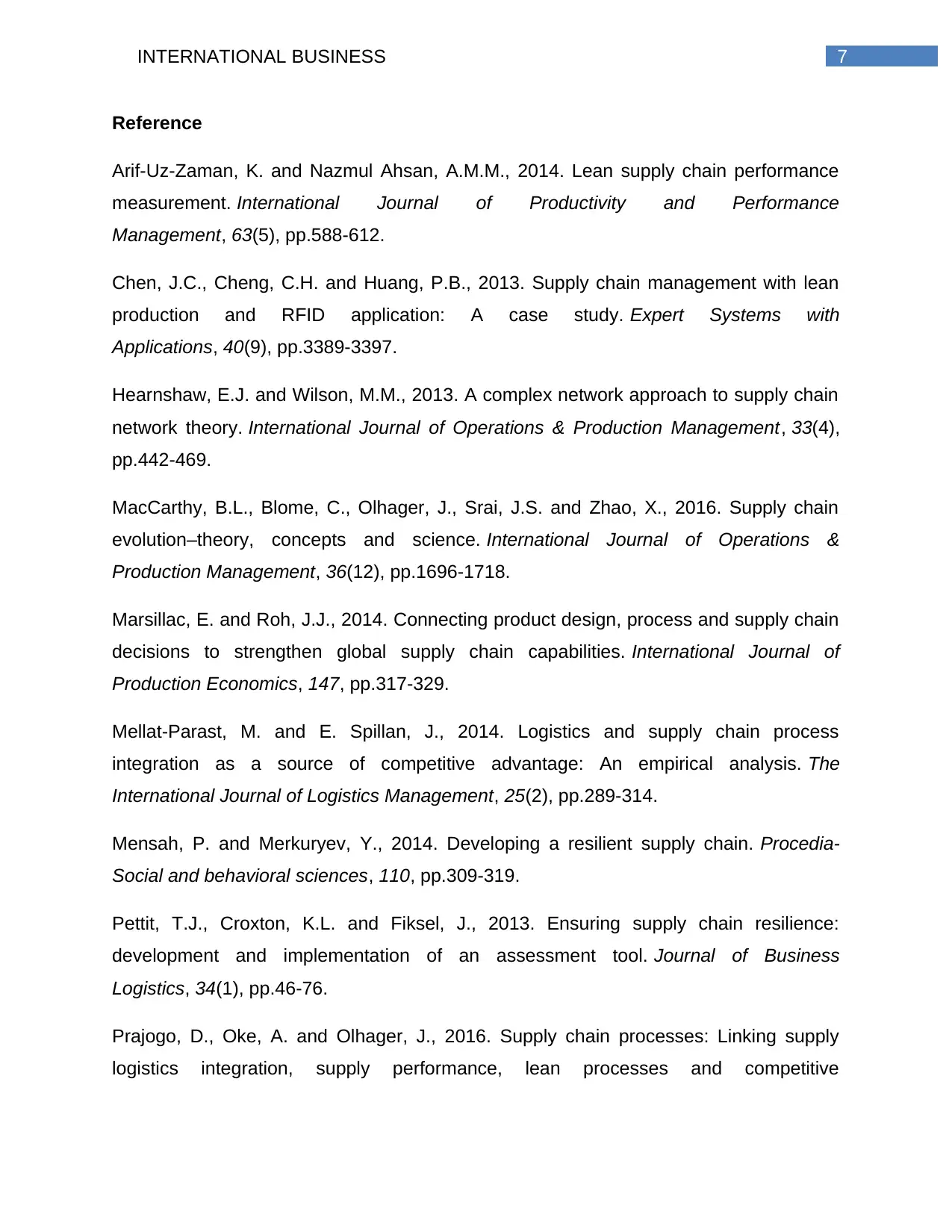
7INTERNATIONAL BUSINESS
Reference
Arif-Uz-Zaman, K. and Nazmul Ahsan, A.M.M., 2014. Lean supply chain performance
measurement. International Journal of Productivity and Performance
Management, 63(5), pp.588-612.
Chen, J.C., Cheng, C.H. and Huang, P.B., 2013. Supply chain management with lean
production and RFID application: A case study. Expert Systems with
Applications, 40(9), pp.3389-3397.
Hearnshaw, E.J. and Wilson, M.M., 2013. A complex network approach to supply chain
network theory. International Journal of Operations & Production Management, 33(4),
pp.442-469.
MacCarthy, B.L., Blome, C., Olhager, J., Srai, J.S. and Zhao, X., 2016. Supply chain
evolution–theory, concepts and science. International Journal of Operations &
Production Management, 36(12), pp.1696-1718.
Marsillac, E. and Roh, J.J., 2014. Connecting product design, process and supply chain
decisions to strengthen global supply chain capabilities. International Journal of
Production Economics, 147, pp.317-329.
Mellat-Parast, M. and E. Spillan, J., 2014. Logistics and supply chain process
integration as a source of competitive advantage: An empirical analysis. The
International Journal of Logistics Management, 25(2), pp.289-314.
Mensah, P. and Merkuryev, Y., 2014. Developing a resilient supply chain. Procedia-
Social and behavioral sciences, 110, pp.309-319.
Pettit, T.J., Croxton, K.L. and Fiksel, J., 2013. Ensuring supply chain resilience:
development and implementation of an assessment tool. Journal of Business
Logistics, 34(1), pp.46-76.
Prajogo, D., Oke, A. and Olhager, J., 2016. Supply chain processes: Linking supply
logistics integration, supply performance, lean processes and competitive
Reference
Arif-Uz-Zaman, K. and Nazmul Ahsan, A.M.M., 2014. Lean supply chain performance
measurement. International Journal of Productivity and Performance
Management, 63(5), pp.588-612.
Chen, J.C., Cheng, C.H. and Huang, P.B., 2013. Supply chain management with lean
production and RFID application: A case study. Expert Systems with
Applications, 40(9), pp.3389-3397.
Hearnshaw, E.J. and Wilson, M.M., 2013. A complex network approach to supply chain
network theory. International Journal of Operations & Production Management, 33(4),
pp.442-469.
MacCarthy, B.L., Blome, C., Olhager, J., Srai, J.S. and Zhao, X., 2016. Supply chain
evolution–theory, concepts and science. International Journal of Operations &
Production Management, 36(12), pp.1696-1718.
Marsillac, E. and Roh, J.J., 2014. Connecting product design, process and supply chain
decisions to strengthen global supply chain capabilities. International Journal of
Production Economics, 147, pp.317-329.
Mellat-Parast, M. and E. Spillan, J., 2014. Logistics and supply chain process
integration as a source of competitive advantage: An empirical analysis. The
International Journal of Logistics Management, 25(2), pp.289-314.
Mensah, P. and Merkuryev, Y., 2014. Developing a resilient supply chain. Procedia-
Social and behavioral sciences, 110, pp.309-319.
Pettit, T.J., Croxton, K.L. and Fiksel, J., 2013. Ensuring supply chain resilience:
development and implementation of an assessment tool. Journal of Business
Logistics, 34(1), pp.46-76.
Prajogo, D., Oke, A. and Olhager, J., 2016. Supply chain processes: Linking supply
logistics integration, supply performance, lean processes and competitive
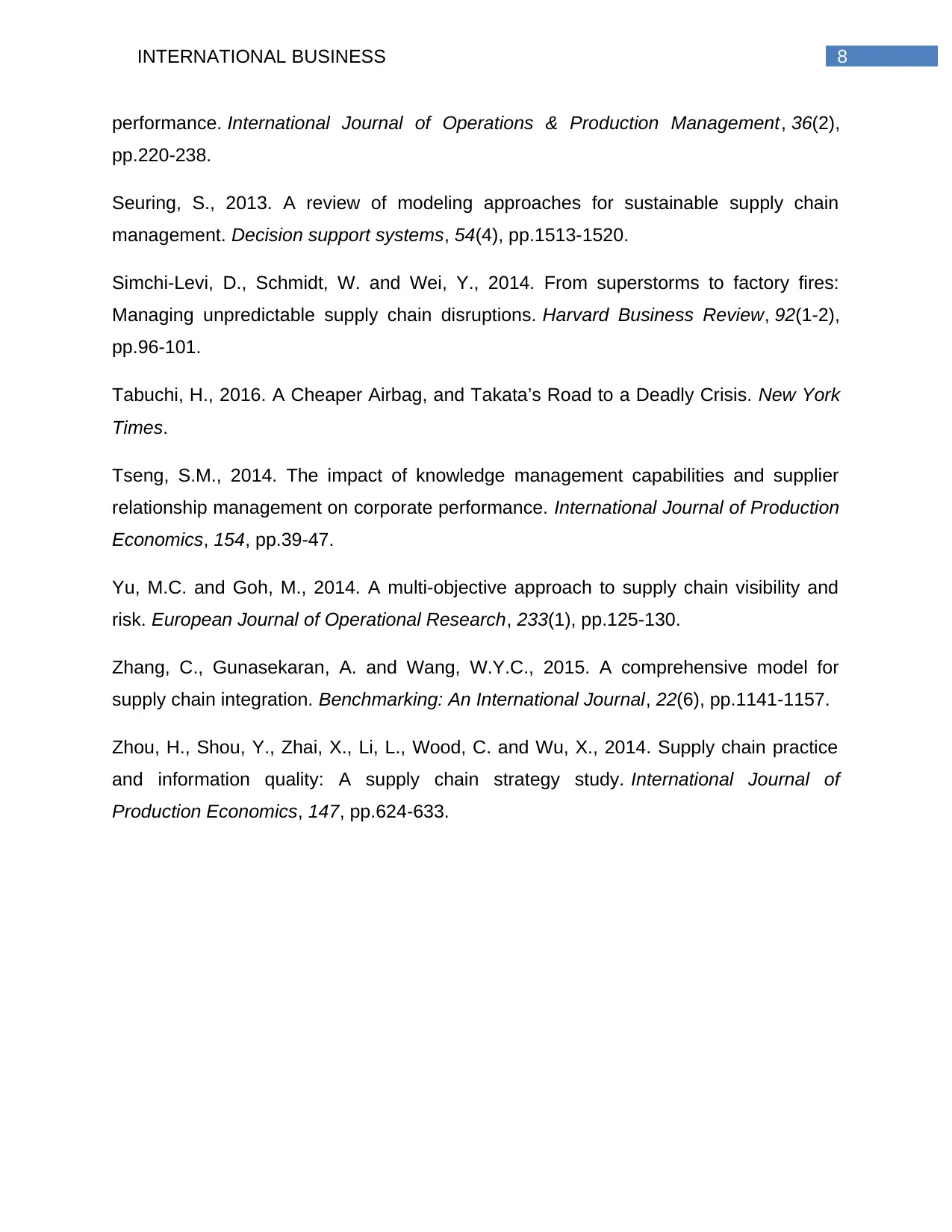
8INTERNATIONAL BUSINESS
performance. International Journal of Operations & Production Management, 36(2),
pp.220-238.
Seuring, S., 2013. A review of modeling approaches for sustainable supply chain
management. Decision support systems, 54(4), pp.1513-1520.
Simchi-Levi, D., Schmidt, W. and Wei, Y., 2014. From superstorms to factory fires:
Managing unpredictable supply chain disruptions. Harvard Business Review, 92(1-2),
pp.96-101.
Tabuchi, H., 2016. A Cheaper Airbag, and Takata’s Road to a Deadly Crisis. New York
Times.
Tseng, S.M., 2014. The impact of knowledge management capabilities and supplier
relationship management on corporate performance. International Journal of Production
Economics, 154, pp.39-47.
Yu, M.C. and Goh, M., 2014. A multi-objective approach to supply chain visibility and
risk. European Journal of Operational Research, 233(1), pp.125-130.
Zhang, C., Gunasekaran, A. and Wang, W.Y.C., 2015. A comprehensive model for
supply chain integration. Benchmarking: An International Journal, 22(6), pp.1141-1157.
Zhou, H., Shou, Y., Zhai, X., Li, L., Wood, C. and Wu, X., 2014. Supply chain practice
and information quality: A supply chain strategy study. International Journal of
Production Economics, 147, pp.624-633.
performance. International Journal of Operations & Production Management, 36(2),
pp.220-238.
Seuring, S., 2013. A review of modeling approaches for sustainable supply chain
management. Decision support systems, 54(4), pp.1513-1520.
Simchi-Levi, D., Schmidt, W. and Wei, Y., 2014. From superstorms to factory fires:
Managing unpredictable supply chain disruptions. Harvard Business Review, 92(1-2),
pp.96-101.
Tabuchi, H., 2016. A Cheaper Airbag, and Takata’s Road to a Deadly Crisis. New York
Times.
Tseng, S.M., 2014. The impact of knowledge management capabilities and supplier
relationship management on corporate performance. International Journal of Production
Economics, 154, pp.39-47.
Yu, M.C. and Goh, M., 2014. A multi-objective approach to supply chain visibility and
risk. European Journal of Operational Research, 233(1), pp.125-130.
Zhang, C., Gunasekaran, A. and Wang, W.Y.C., 2015. A comprehensive model for
supply chain integration. Benchmarking: An International Journal, 22(6), pp.1141-1157.
Zhou, H., Shou, Y., Zhai, X., Li, L., Wood, C. and Wu, X., 2014. Supply chain practice
and information quality: A supply chain strategy study. International Journal of
Production Economics, 147, pp.624-633.
1 out of 9
Related Documents
Your All-in-One AI-Powered Toolkit for Academic Success.
+13062052269
info@desklib.com
Available 24*7 on WhatsApp / Email
![[object Object]](/_next/static/media/star-bottom.7253800d.svg)
Unlock your academic potential
© 2024 | Zucol Services PVT LTD | All rights reserved.





